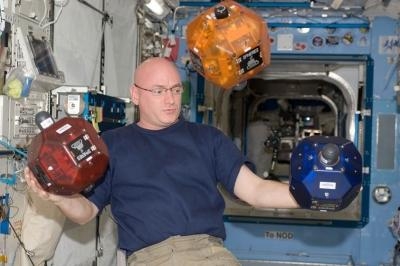Fri, Mar 21, 2014
Paves The Way For Future Deep Space Missions
In a breakthrough that will help make it possible for astronauts and robots to work together in deep space, researchers at the Lockheed Martin Advanced Technology Center (ATC), working with NASA astronauts aboard the International Space Station, have demonstrated coordinated control of robots in space by astronauts in space and operators on the ground. The breakthrough is the first-ever demonstration of such collaborative tele-operations. The maneuvers create new opportunities to extend the reach of human and robotic missions in Earth orbit and beyond.

Astronaut Karen Nyberg and ATC engineer Humberto Ormeno used an ATC-developed, 3-D user interface to command NASA's Synchronized Position Hold, Engage, Re-orient, Experimental Satellites (SPHERES) robots on the space station. Inside the space station, the robots (each about the size of a soccer ball) were commanded in "follow-the-leader" exercises and simulated approach-and-docking maneuvers, like those required for in-space assembly of large space structures and asteroid exploration. There is also flexibility within the system, meaning automated control of one or more robots can be combined with manual control of another.
Remote commanding of robots in space, or tele-operation, poses several unique challenges. Commands and telemetry can take one to three seconds to travel between space and the ground via satellite relays, forcing remote operators to predict the effects of their actions using old data. Delicate components designed for weightlessness can be damaged by accidental collisions or even exhaust gases produced by other satellites, so safe maneuvering is essential. The work on the space station is demonstrating how to deal with the time delays associated with signal transfer from the ground.
"The ATC has started to confront these challenges by performing multiple experiments with the SPHERES robots, through a no-cost Space Act Agreement with the International Space Station National Laboratory Office," said Dr. Nelson Pedreiro, ATC director of Science and Technology. "This technology exemplifies how breakthroughs can be achieved in a cost-effective and agile manner."
"Supervising a team of robots in microgravity requires intuitive and informative user interfaces so operators can maintain control over sensitive maneuvers without being overwhelmed by details," says Andrew Zimdars, who leads the ATC effort. "SPHERES enables us to work with the astronauts who will command future exploration missions and develop software technologies that meet their needs."
(SPHERES image provided by NASA)
More News
Aero Linx: International Federation of Airworthiness (IFA) We aim to be the most internationally respected independent authority on the subject of Airworthiness. IFA uniquely combi>[...]
Ultrahigh Frequency (UHF) The frequency band between 300 and 3,000 MHz. The bank of radio frequencies used for military air/ground voice communications. In some instances this may >[...]
A Few Questions AND Answers To Help You Get MORE Out of ANN! 1) I forgot my password. How do I find it? 1) Easy... click here and give us your e-mail address--we'll send it to you >[...]
From 2019 (YouTube Edition): Learning To Paint Without Getting Any On Your Hands PPG's Aerospace Coatings Academy is a tool designed to teach everything one needs to know about all>[...]
Also: Sustainable Aircraft Test Put Aside, More Falcon 9 Ops, Wyoming ANG Rescue, Oreo Cookie Into Orbit Joby Aviation has reason to celebrate, recently completing its first full t>[...]
 ANN's Daily Aero-Linx (05.06.25)
ANN's Daily Aero-Linx (05.06.25) ANN's Daily Aero-Term (05.06.25): Ultrahigh Frequency (UHF)
ANN's Daily Aero-Term (05.06.25): Ultrahigh Frequency (UHF) ANN FAQ: Q&A 101
ANN FAQ: Q&A 101 Classic Aero-TV: Virtual Reality Painting--PPG Leverages Technology for Training
Classic Aero-TV: Virtual Reality Painting--PPG Leverages Technology for Training Airborne 05.02.25: Joby Crewed Milestone, Diamond Club, Canadian Pilot Insurance
Airborne 05.02.25: Joby Crewed Milestone, Diamond Club, Canadian Pilot Insurance



